Insulation and Global Warming at the Passive House Conference
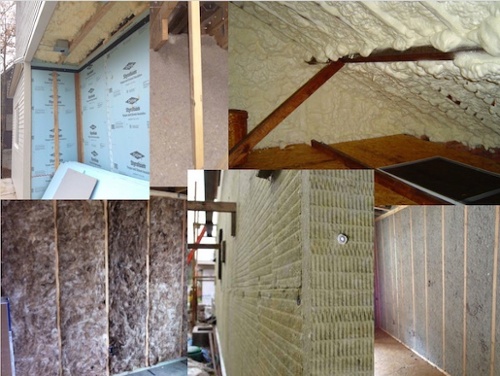
Diminishing returns and payback
I don’t know why it took me so long to figure this part out, but I didn’t see it when I first wrote about Wilson’s payback calculations. Now it seems pretty clear. Let’s see if I can convince you.
To calculate how many years it takes to pay back the cost of something, you need to know what the savings are per year. In this case, we’re not talking about money. We’re talking global warming emissions, but the principle of payback is the same. In Wilson’s calculations, he used a calculation method for energy savings that made two of the insulation types look really bad. (Those two were extruded polystyrene and closed cell spray polyurethane foam.)
That calculation method was that energy savings due to the highly-insulated walls they looked at was split into two parts. The initial energy savings went to the cellulose insulation in the 2×6 wall cavities, with a whole-wall R-value of R-14. Then they added more insulation of the various types they studied and calculated how much energy that “extra” insulation saved.
That might make sense if you have an existing home with already-insulated 2×6 walls. But if you’re building a new home, I argue it doesn’t make sense. More on that in a bit.
The reason that splitting the energy savings like that yields misleading results is due to diminishing returns. As you can see in the graph below, by the time a wall is insulated to R-14, it’s already got most of the energy savings it’s ever going to get. You can keep adding more, but you get less and less energy savings for each additional inch of insulation. The returns diminish.
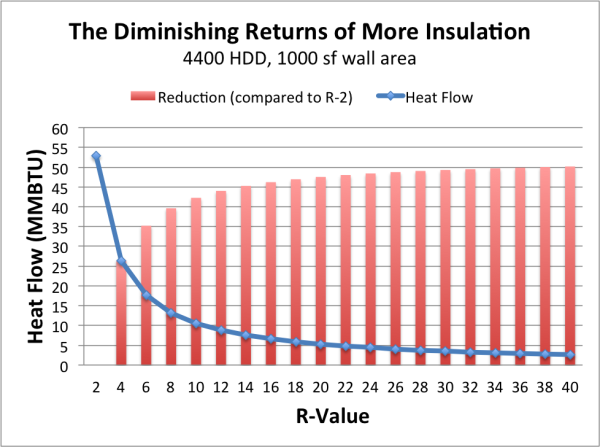
Calculating in a different order
Let’s take a look at some actual numbers. I used a total R-value of 59, split into two parts: R-14 (representing the insulation in the cavities) and R-45 (the additional insulation on the exterior). When I calculate the amount of energy savings attributable to the R-14 first, I get the graph below. The cavity insulation saves about 51 MMBTU per year. The exterior insulation saves about 6.5 MMBTU per year. The cavity insulation saves 7.9 times as much energy as the exterior insulation.
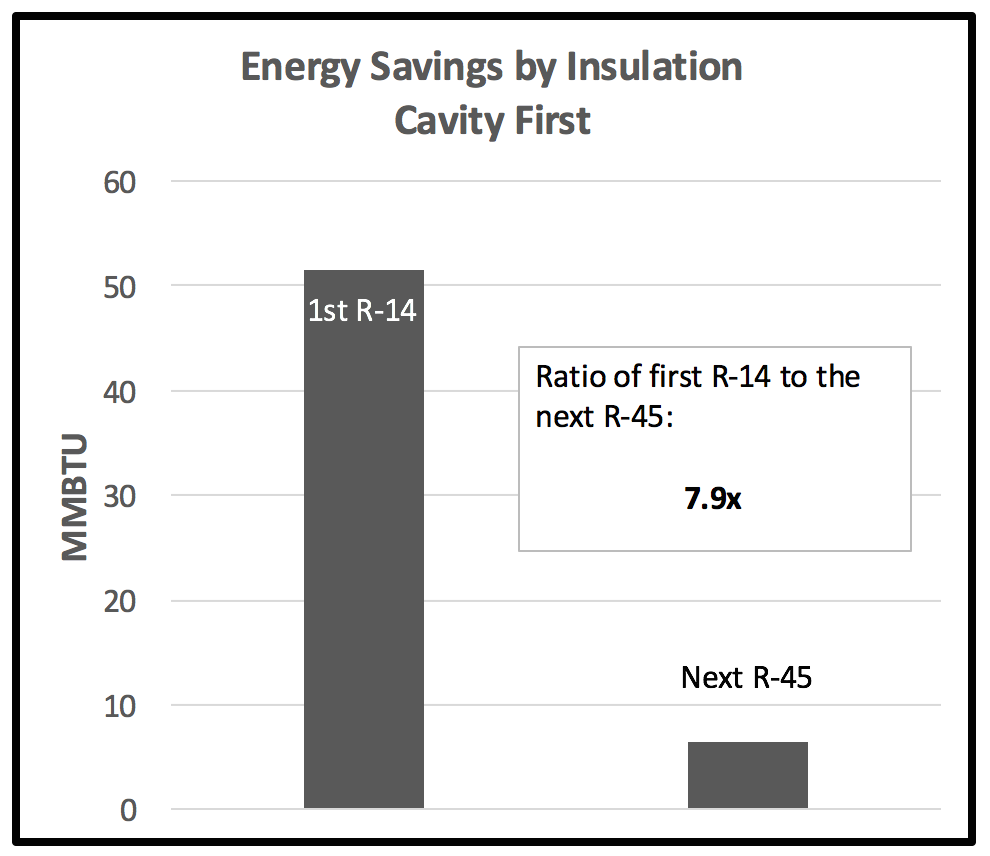
If I do that same calculation in the reverse order, the results are very different, as shown below. The R-45 exterior insulation will save 57 MMBTU per year, and the R-14 cavity insulation saves only 0.6 MMBTU per year. So the exterior insulation saves about 91 times as much energy as the cavity insulation here.
Looking at it this way, you might say, “Hey, we’ve already got 98.9% of the savings with the R-45. Why don’t we just skip the cavity insulation? We’ll get almost the same performance.”
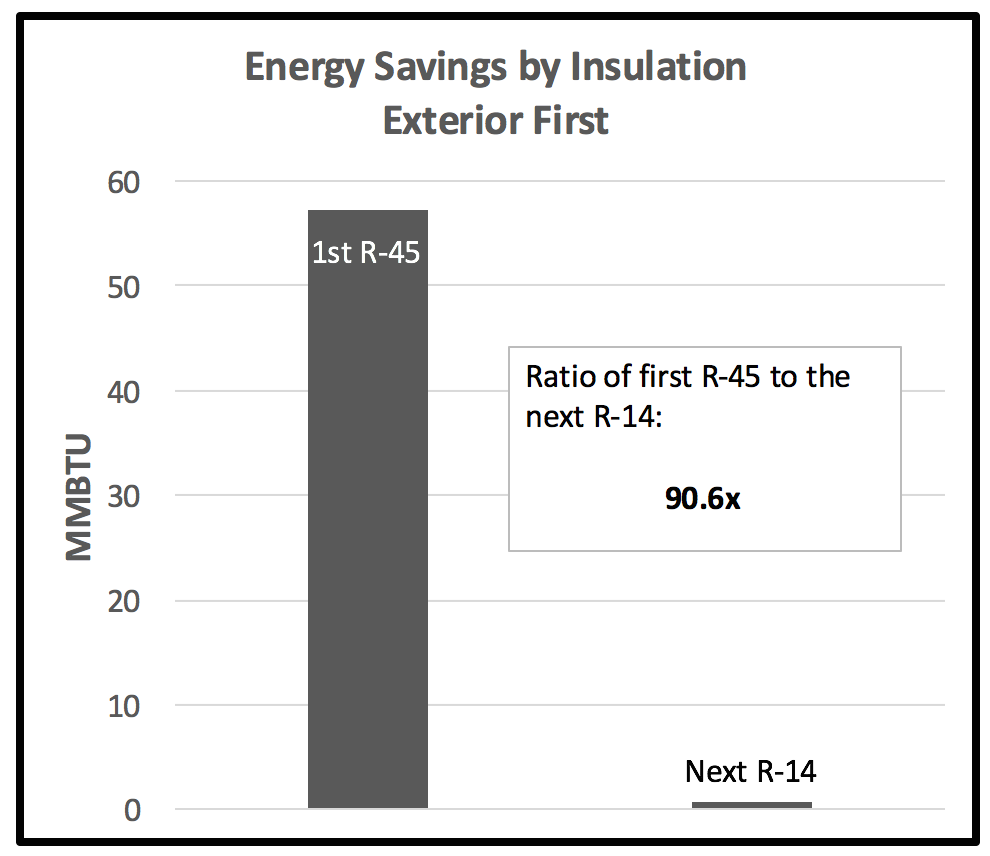
The effect on payback
How do these results affect Wilson’s payback calculations? Let’s work through the calculation. First, here’s the equation for simple payback:

Regardless of which order you use to calculate the energy savings, the cost in global warming impact should remain the same. The global warming emissions from the making of the insulation (all types) and the emissions from the blowing agents (foam) don’t change.
So to calculate the effect of calculation order on payback, we need to adjust the denominator in that little equation. What we want to know is the ratio of the savings when you calculate the R-45 exterior insulation first versus when you calculate it second. And those numbers are 57.3 MMBTU/year for R-45 first versus 6.54 MMBTU/year when you calculate the R-45 savings second. That ratio is:

The conclusion here is that you get 8.8 times as much energy savings simply by calculating in the reverses order. Let’s apply that to Wilson’s results.
Here’s the graph Wilson presented for doing the calculation with the R-45 savings second.


Just by reversing the order, the payback for all insulation types, even the two “bad” ones, drops to less than 20 years. You have to go well past R-60 to hit 20 years, but the insulation should last 50 years or more.
What R-value should you use?
One other thing I pointed out about this issue is the actual R-value used. Wilson’s graph goes all the way up to R-60. Do you ever need to use that much? We know about the diminishing returns of adding more insulation. When does it make sense to stop? Well, we now have some good guidance from the Passive House Institute US (PHIUS).
Here’s a table of R-values that meet the PHIUS climate-specific standard in different climate zones. Up to climate zone 3, R-30 or less is all you need. For climate zones 4, 5, and 6, you can stop at about R-50. It’s only in the sparsely populated climate zones 7 and 8 that you need lots and lots of insulation, especially in zone 8.
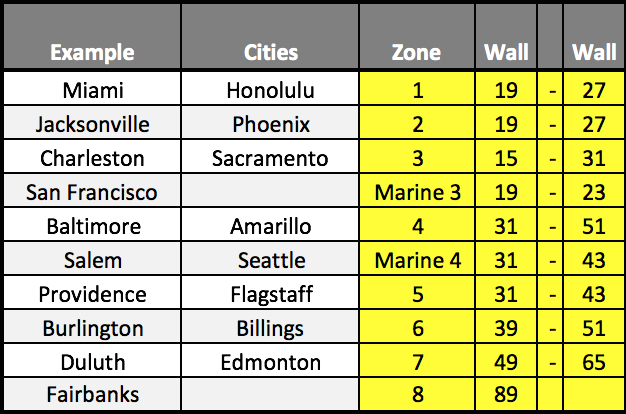
When you look at graphs like Wilson’s, whether adjusted the way I’ve done or not, keep these numbers in mind.
In case you’re wondering, the numbers I calculated above include only the energy savings due to heating.
The baby and the bathwater
If you buy into my argument, you should agree that Wilson’s conclusion to avoid XPS and ccSPF wasn’t warranted. If you don’t buy into my argument, please let me know why. I’m not saying those two materials are neutral in all respects in comparison to other insulation materials. There are certainly other issues to consider. But when we look just at energy savings and global warming impact, XPS and ccSPF aren’t as bad as it first seemed.
Wilson’s study, however, is still important. As I pointed out in my last article on this topic, the real significance of what he did was to get us thinking about this issue and actually calculating global warming impact. David White of Right Environments in Brooklyn developed a spreadsheet calculator to do just this. And that’s the subject of the second part of my conference presentation, which I’ll discuss in my next article on this topic. Stay tuned.
Download the slides from my North American Passive House Conference presentation
This Post Has 16 Comments
Comments are closed.

Hello! I’m a novice builder,
Hello!
I’m a novice builder, and always find your articles informative, interesting, very well articulated, and often funny. THANK YOU SO MUCH FOR PROVIDING SO MUCH GOOD INFORMATION FOR ANY AND ALL TO LEARN!
Much appreciation and respect,
A. F.
Glad you find it useful, Anne
Glad you find it useful, Anne.
Hey Allison, when do you
Hey Allison, when do you think we will ever see a blog post like this but one that shows how global warming can be reduced through air sealing???? I get the insulation argument and really appreciate how you have defended the spray foam insulation technology. When will the building envelope industry really start to embrace new air sealing technologies? To me, most of the math on that idea is already in the books, but the default always seems to a discussion of insulation. Just my two cents.
Bill, you make an excellent
Bill, you make an excellent point. The exclusion of airtightness was one of my complaints when I first wrote about this six years ago. In my last article, I wrote that we shouldn’t be considering insulation materials separately either. At the minimum, we should look at complete assemblies. Better would be to look at the whole enclosure, which would capture it all.
Hey Allison,
Hey Allison,
I feel your pain. I have the scars to show for my battles with the industry when it comes to defending air sealing technology. After a whole lot of time and money invested into this fight, I came to a decision in March of this year to abandon our efforts to try to position our air sealing technology into the global warming discussion and have been focused solely on our products. My theory is that some day there will be an awakening to this idea, but I will probably be dead and gone by then. Also, when you have so many other CleanTech ideas now being funded/subsidized that are so much ” sexier ” than insulation/air sealing my guess is that we have a real uphill battle with this message. Thanks for pressing on and good luck!
I think I echo William’s
I think I echo William’s thinking. The function of insulation in our projects goes far beyond mere R-Value. That’s important in the Jax, FL high humidity zone 2 climate.
CC foam provides a vapor barrier, adds structural strength, often brings ductwork into indirectly conditioned space, and reduces infiltration.
How do those difficult-to-quantify benefits figure into the calculus?
I don’t necessarily advocate foam for walls since a decent air seal can be obtained without it and ductwork aspects don’t figure in.
Our favorite wall is ICF, which, while probably flunking for embodied energy, also has difficult-to-quantify benefits as they are strong, quiet, inorganic, essentially air tight, and confer useful thermal mass.
Curt, I agree. And yes, I
Curt, I agree. And yes, I also recommend SPF insulation for floors and ceilings over walls. Except foundation walls. Closed cell SPF on basement or crawl space walls is about the best way to insulate there.
I would not describe ICF as
I would not describe ICF as inorganic as it consists mostly of organic expanded polystyrene. Materials such as AAC or cellular lightweight concrete (CLC) are totally inorganic and cannot burn. They are also strong, quiet, air tight and have a good thermal mass. Companies such as Greentec Construction Technologies (https://greentecct.com/) offer molds and equipment for producing CLC products such as blocks and panels.
Great discussion.
Great discussion.
It bears repeating though that the connection of reducing global warming through efficiency improvements of any kind is tenuous at best. The only real ‘solution’ to limiting global warming is to keep fossil carbon fuels in the ground permanently. The prime driver of global warming is consumption due to affluence derived from fossil fuel use. Large houses with many bump-outs don’t help.
No permanent mitigation will be achieved unless efficiency improvements achieve cost-savings that can *only* be spent within an economy that guarantees steady reductions in whole-economy carbon emissions. Our economies are vastly more efficient than 50 years ago but they emit more carbon in total as they are bigger. The essentially permanent and irreversible level of warming will continue to increase until net carbon emissions reach zero.
Efficiency improvement is good but it will not result in climate mitigation unless the economy acts within an enforced and annually decreasing cap on total emissions.
Working within such a capped emission pathway to zero carbon would require massively more efficiency work and energy demand reduction than hitherto envisaged. It might even employ a lot of people to get it done.
All good points, Paul. You
All good points, Paul. You touched on what I think is the most fundamental issue of all: growth. Becoming more efficient with energy is great, but all it does really is buy some time. The global economy is based on the premise that it must keep growing. When we can adjust our thinking and figure out how to get to a steady state economy, we’ll be on the way to finding a real solution. Can we solve the climate crisis with continued growth? I don’t know but it seems doubtful.
Here’s an article I wrote a few years ago about the topic:
The End of Growth – Mathematics & Peak Oil
http://www.energyvanguard.com/blog-building-science-HERS-BPI/bid/29920/The-End-of-Growth-Mathematics-Peak-Oil
As we continue the debates on
As we continue the debates on this and that someone anyone should look up and see what is really going on. Material usage has changed and all past arguments have made a 180 and nobody seems to have noticed.
Composite Sandwich Core Construction changes how we can and should build homes to meet our goals for the implementation of producing Net Zero Structures to meet more sustainable demands on the industry. Using Insulation for Framing and Insulating in one product saving both time and money, who knew.
I also agree with the
I also agree with the comments on impacts of air sealing and moisture management outside of insulation studies.
A couple of comments on both your text and graphics. The diminishing return in heat flow is the only guaranteed graph – the payback graphs ASSUME certain costs (both initial installation of insulation and heating); if the install cost goes down payback speeds up or if heating costs increase payback speeds up. The insulation R values you talk to are NOT the wall/ceiling average R values, just the insulated cavity (or exterior sheathing) so this graph does not take into account the increased average wall/ceiling R value due to reduced thermal bridges using exterior insulation. In any of the zone recommendations there is always an inherent number that is not so evident to most observers – comfort set points for the PHIUS heat gain/loss and cost/payback for most other recommendations. It does not take into account that insulation material (for the most part) is one of the cheapest building materials used in construction – it is the labor that is much more expensive. So adding additional insulation at the onset incurs a minimal cost overage – especially if future costs of heating/cooling (or different comfort desires) would dictate additional insulation (at additional future labor costs).
An insulation topic for a
An insulation topic for a future article. The typical R-value for polyisocyanurate foam is R6 per inch. I’ve seen articles that say because of off gassing the aged value of it is down around R5.4 per inch, even for foil faced foam. And also that in cold temperatures this type of foam performs even worst.
We recently had an Insulated Metal Panel (IMP) sales rep at our office claiming their product is R8 per inch. It’s got a metal outer skin on both sides and polyisocyanurate foam in the core. I’ve been challenging her on these claims in emails back and forth. Every concern I raise gets an answer. I appreciate the company responsiveness but my mind still doesn’t want to accept the results.
I asked for any laboratory tests of their product. I get one from an independent lab of one of their 6″ wall panels. It was two parts with the panels secured together with their typical steel clips and butyl sealant. So this test included a seam in the panel system. Total surface area of 40 sf. Warm side at 69.8 F and cold side at -0.2 F. Even a wind of 15.6 mph on the cold side. Test duration of 4 hours. The measured thermal resistance for this 6″ panel system was 48.92 (hr)(ft2)(F)/Btu. Adding the skin effect they got 50.15.
I’ve asked for any testing of aged panels but they don’t have any tests like this. I’ve search the web and can’t find any data on aged panels either.
What am I missing? What should I ask or demand? Can the 26 gage steel skins prevent all degradation of the foams R-value as they claim?
As a builder, when I start
As a builder, when I start the conversation with new clients regarding energy efficiency and insulation, I always educate them on the three ways heat energy transfers in and out of a structure (conduction, convection, radiation). All three need to be considered and addressed in some manner. The key is to determine which one(s) will give the greatest return and thus deserve extra attention. The first dollar that I spend is on convection because if I cannot control air movement in and out of the structure, everything else is a waste of money. So, the first inch of spray foam delivers the greatest bang for the buck. Convection issues in the structure itself are stopped dead. Once that is done, I can move on to conduction and radiation. Adding additional insulation as appropriate with either fiberglass or more inches of foam becomes more of a cost based decision. (Note: Closed cell foam is awesome for increasing structural integrity as an extra benefit). Lastly, as we are in Coastal NC with a lot of summer heat gain, I use either standing seam metal roofing or some form of reflective barrier under the roof to reduce the effects of radiant heat. Above and beyond, I never build stick frame construction due to all of the inherent weaknesses structurally and energy wise. Starting in 2010, I only build using a precast insulated concrete wall system from Superior Walls of America. My houses are build like a boat, sealed tight, and can resist damage from hurricanes, tornadoes, wildfires, earthquakes and floods. I haven’t however, come up with a solution for Florida sinkholes.
Thomas, I have heard a lot of
Thomas, I have heard a lot of ways to present the insulation/air sealing concept but what you have posted here is brilliant. Thanks for sharing.
I’m confused.
I’m confused.
How do you equate payback in terms of years when you haven’t expressed the GWP in terms of MMBTU’s?